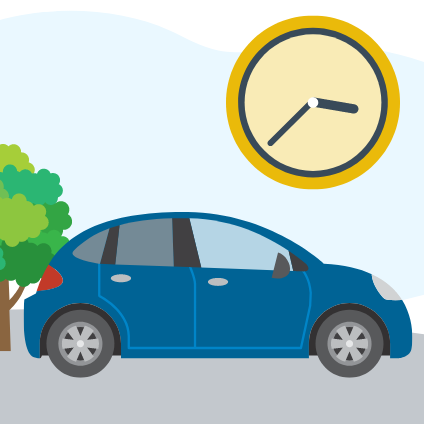Winter and Cold Weather Safety Tips for Drivers

Even when the weather outside gets frightful, preparing a plan and following best practices can help to ensure you and your automobile stay safe throughout the winter season and during periods of extreme cold.
Winter weather in New England is as unpredictable as it can be intense – whether it is freezing temperatures, powerful and disruptive snowstorms, more hours of darkness, or black ice, the season brings about a unique set of potential hazards that, with a plan in place and proper precautions taken, can be minimized to keep your automobile protected and people safe while on the road.
Preparing for Winter and Cold Weather
Weather events, like polar vortexes and winter storms that may range from moderate snow in a short amount of time to a blizzard lasting for days, are occasions that require thoughtful preparations. Before a winter storm hits or periods of extreme cold set in, make sure you know key terms:
- Winter Storm Watch: Be alert, a storm is likely.
- Winter Storm Warning: Take action, the storm is in or entering the area.
- Blizzard Warning: Snow and strong winds combined will produce blinding snow, near zero visibility, deep drifts, and life-threatening wind chill. Seek refuge immediately!
- Winter Weather Advisory: Winter weather conditions are expected to cause significant inconveniences and may be hazardous, especially to motorists.
- Frost/Freeze Warning: Below freezing temperatures are expected and may cause damage to pipes, plants, and/or fruit trees as well as contribute to the formation and accumulation of black ice.
- Cold Wave: As defined by the U.S. National Weather Service, a rapid fall in temperature within a 24-hour period requiring substantially increased protection to agriculture, industry, commerce, and social activities.
In addition to understanding key terms, you can also take actions before winter weather occurs to keep your car or truck in good operating condition and get yourself ready for driving in inclement weather:
- Review the “Three P’s” of safe winter driving: Prepare (for the trip), Protect (yourself and others), and Prevent (crashes) – are a helpful framework to help you get ready to drive, if conditions allow, and to keep you and others safe while you are on the road.
- Survey Your Vehicle: Does your heat work? When was the last time you checked your tire pressure and car battery? Are you due to swap in some new air filters? Do your windshield wipers work properly? Does your emergency kit need to be restocked? Additionally, leverage tools like the National Safety Council’s My Car Does What?campaign that helps to “educate drivers about the safety features built into vehicles.Search for your carand find out what safety features are already built in.”
Keeping Safe During the Winter Season and Periods of Extreme Cold
Winter weather and cold temperatures create conditions that make roads hazardous and creates more dangers for drivers. Analyzing risks and planning your trip accordingly are critically important. Some things to consider before you hit the road and while you are driving:
- Only Travel If Necessary: Sometimes, it is simply better to stay home and avoid unnecessary risks.
- Increase Safety Precautions: Whether it is driving at slower speeds, leaving more distance between your car or truck and other vehicles, and/or sharing your travel plans with someone in advance, these are some of the things you can do to mitigate risks while on the road and keep yourself safe.
- Stay Alert: As always, be careful to not engage in distracted driving and maintain your focus on the road and your surroundings; follow existing laws and regulations like speed limits and those that prohibit driving while intoxicated and require hands free driving. Be on the lookout for changing conditions like black ice and alter your behavior accordingly.
- What to Do in an Emergency: Call 911 and stay with your car or truck, your vehicle will keep you warm and it is important to not overexert yourself. Increase your visibility by keeping your interior lights on and/or tying a brightly colored cloth or article of clothing to signal for help and make it easier for rescuers to find you. Make sure you are aiming to conserve gas and that you clear the exhaust pipe to prevent the buildup of carbon monoxide.
By following these easy steps and maintaining the proper insurance coverage, you can enjoy the winter weather without worry. Our personal auto insurance policies provide coverage for bodily injury and property damage to others, no-fault personal injury coverage for your vehicle's occupants, and physical damage coverage for your own vehicle for collision or other perils.
Safety aims to ensure that we provide the highest standard of service to our policyholders – we offer increased coverage for convenience and peace of mind through our Safety Shield Plus, a broad coverage endorsement for your Personal Auto Insurance policy which includes:
- Disappearing Collision Deductible
- Accident Forgiveness
- Guaranteed Replacement Cost
- Emergency Road Travel Expenses
- Extended Substitute Transportation
- Supplemental Towing & Labor
- Emergency Road Travel Expenses
- Rental Vehicle Loss of Income
- Personal Effects Coverage
- Pet Coverage
We also offer enhancements for Commercial Auto policy.
Please view our products for more information on our endorsements and connect with us on Facebook and Twitter to receive the latest updates.
Please contact your independent agent and they will be happy to answer any questions about coverage. Safety Insurance helps you manage life’s storms both online and in person.





